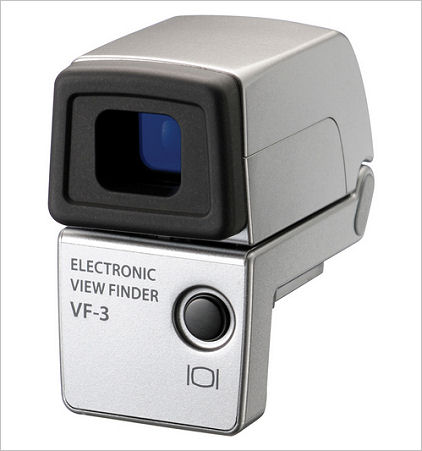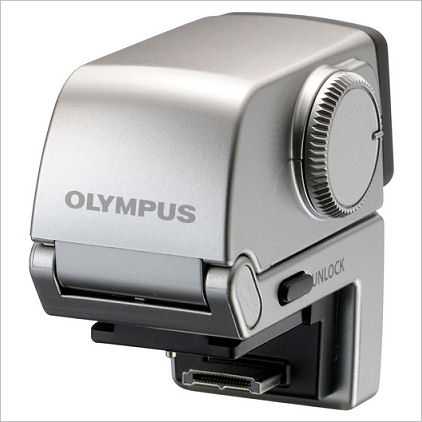

Olympus VF-3 Review

A little while ago I bought an Olympus PEN E-PL1 (See Review here) because I wanted something smaller than my DSLR but with better image quality than my P&S. The Olympus PEN series four-thirds format cameras do that job very well. In addition, because of the short flange to sensor distance of the micro 4/3 mount, just about any lens ever made for any 35mm camera can be adapted to the Olympus PEN series cameras. Of course they don't autofocus, and that's where the VF-3 comes in.

VF-3 mounted on my E-PL1 with a Konica 57mm f1.2 manual focus lens attached
While you can use the rear LCD of the PEN series cameras to manually focus a lens, and you can magnify the image (7x, 10x or 14x in the case of the E-PL1), it's not very convenient to say the least. Holding the camera out at arms length while looking at the LCD and turning the lens' focusing ring just isn't a natural action for me. Actually, even when using an Olympus autofocus lens I find myself holding the camera up to my eye - which without a viewfinder doesn't do me much good since I can't then see what I'm shooting.
I resisted buying an accessory electronic viewfinder for months because I couldn't really see spending $225 for the Olympus VF-2 or even $175 for the Olympus VF-3. The accessory electronic viewfinders just seemed too expensive to be worth the cost. But I was wrong.
I broke down and bought the Olympus VF-3 Electronic Viewfinder and it's transformed the camera into something much more user friendly. It now feels very natural using a manual focus lens and even using an AF lens I prefer the viewfinder to the LCD. I don't know the refresh rate of the VF-3 image, but it must be pretty high. With normal panning I don't notice any smearing of the image, though as with any EVF you can see some smearing effects with a rapid pan.
The VF-3 differs from the VF-2 in a number of ways. First it has a lower pixel count. The VF-3 is 640x480 pixels while the VF-2 is 800x600 pixels. However the VF-3 has two major advantages. First it locks onto the camera hotshoe via a pin. It can't fall off or be knocked off by accident. The VF-2 just slides into the hot shoe with no mechanism other than friction to keep it in place. The second advantage of the VF-2 is that it's $50 cheaper. It's also slightly smaller, but that's no big deal.

As I said, the VF-3 display is 640x480 pixels and shows all the information that is normally on the LCD. There's a button on the VF-3 that switches display between the camera LCD and the VF-3 LCD. Both images can be magnified by 7x, 10x or 14x from the E-PL1 camera body. However even without magnification I found I could manually focus pretty much any lens with excellent accuracy. From a 57mm f1.2 Konica lens to an 8mm f3.5 fisheye to a 500mm f8 mirror lens I had no trouble hitting exact focus.
If you are really obsessive about colors, you can even adjust the color balance of the VF-3 display via a menu of the E-PL1 camera body though I'm not sure why you would bother. Brightness is also adjustable. The VF-3 itself has an adjustable diopter setting from +1 to -3. About color...it shifts if you move your eye off center. I know this bothers some people and it would be nice if it didn't, but I'm really interested in the VF-3 to aim the camera and show me focus with MF lenses. I'm not that concerned that the viewfinder image is exactly the "right" color. You also get the sharpest image for focusing if you keep your eye in the center of the eyepiece.
Both the VF-2 and VF-3 have another very useful feature. They can be tilted up to 90 degrees, which makes some shots, such as those with the camera body low to the ground, much easier to take. Olympus supply a small soft case to store the VF-3 when it's not in use. The case can be attached to the camera strap.
Note that the PEN E-P2, E-PL1, E-PL2 and XZ-1 require a firmware update to properly operate the VF-3. The update and installation instructions are available from the Olympus website. It's basically a matter of downloading the software, connecting the camera to a computer via the USB cable Olympus provide with the camera, running the software and waiting a few minutes for the update to complete. Mine took about 3-4 minutes, so if you think it's stuck, just keep waiting. I don't know what takes it so long, but it does eventually finish! The most recent PEN models come with compatible firmware installed.
Olympus VF-3 Specifications
- Resolution: Approx. 920,000 dots (VGA, 640x480 pixels)
- 100% field of view
- Approx. 1.00x magnification (-1mı, 50mm Macro, at infinity)
- Eye-point: Approx. 17.4mm (-1mı)
- Diopter adjustment (-3.0 to +1.0mı)
- Tilting mechanism
- Shoe-lock mechanism
- 1.00" (W) x 1.70" (H) x 1.75" (D) (25.4mm x 43.5mm x 44.7mm)
- Approx. 1.0 oz (28g) without cover
Conclusions
Yes, it's a bit expensive for what it initially might seem to be, but it does transform the camera. I find holding the camera at eye level a much more natural action, plus holding it against your eye tends to stabilize it significantly. If you are using a manual focus lens it turns a clumsy, slow operation into a quick and natural movement. The VF-3 (or the VF-2 if you prefer it) might seem somewhat expensive for a viewfinder, but it's worth it and it's almost an essential accessory for manual focus work. The image in the VF-3 is pretty good as long as you keep your eye centered in the eyepiece. If you move to one side the color shifts and sharpness drops. I wish it didn't do this, but it's not something that prevents the VF-3 doing what I need it to (help me aim and focus the camera). Though $175 seems a lot for something so small and light, in the scheme of things it's way cheaper than most lenses and I'm certainly not sorry I bought one. In fact I wish I'd bought one sooner. I'd have been happier if it had been $100, but I'd be happier if most things were cheaper!
